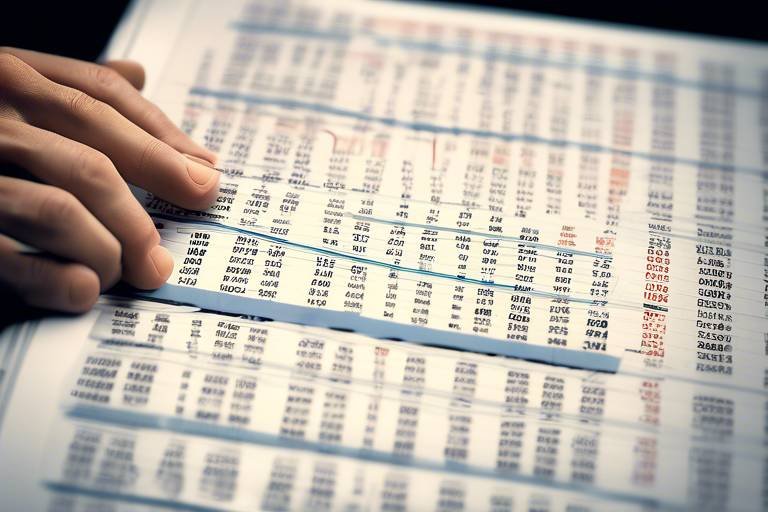How to Stay Disciplined in Your Trading
Trading can be an exhilarating ride, filled with ups and downs that can make your heart race. But, just like any thrilling adventure, it requires a strong sense of discipline to navigate successfully. Imagine you're on a roller coaster; the thrill is undeniable, but without a secure harness, the ride can quickly turn chaotic. This analogy perfectly encapsulates the essence of trading discipline. In this article, we’ll explore effective strategies and techniques to maintain discipline in trading, ensuring consistent performance and minimizing emotional decision-making for long-term success.
At its core, discipline in trading means sticking to a set of rules and strategies that you’ve established for yourself. It acts as your safety net, preventing you from making impulsive decisions that can derail your trading journey. Think of it as a traffic light; it tells you when to go and when to stop, helping you avoid accidents on the trading road. This adherence to a disciplined approach allows traders to maintain a steady pace, avoid emotional pitfalls, and ultimately achieve their financial goals.
One of the most effective ways to cultivate discipline in trading is by setting clear goals. These goals should be specific, measurable, achievable, relevant, and time-bound—a framework commonly referred to as SMART goals. For instance, instead of saying, "I want to make money trading," you might say, "I want to achieve a 10% return on my investment within the next six months." This clarity provides direction and motivation, acting as a compass that guides you through the trading landscape.
Another crucial aspect of maintaining discipline is identifying a trading style that aligns with your personality and risk tolerance. Think of your trading style as your personal brand; it reflects who you are and how you approach the market. There are several styles to choose from, and understanding them can help you make a more informed decision:
- Day Trading: This involves making multiple trades within a single day, capitalizing on small price movements.
- Swing Trading: This style focuses on holding positions for several days or weeks to benefit from expected price moves.
- Long-Term Investing: This approach requires patience, focusing on the long game rather than immediate gains.
Choosing a style that resonates with you can significantly enhance your discipline, allowing you to adopt a more tailored and consistent approach to your trading activities.
Understanding the differences between day trading and swing trading can help you choose a style that suits your lifestyle. Day trading may appeal to those who thrive on fast-paced environments, while swing trading can be ideal for those who prefer a more measured approach. Each style has its own set of rules and strategies, so it’s essential to align your choice with your personal preferences and lifestyle.
On the flip side, long-term investing requires a different mindset. It’s about patience and resilience, focusing on the bigger picture rather than short-term fluctuations. This long-term perspective can significantly contribute to overall trading discipline, as it encourages traders to ride out the market's ups and downs without getting rattled by momentary volatility.
A well-structured trading plan is like a roadmap for your trading journey. It outlines your strategies, risk management rules, and performance evaluation methods. A good trading plan not only helps you stay disciplined but also allows you to measure your progress over time. Here’s a simple structure to consider when developing your trading plan:
| Component | Description |
|---|---|
| Trading Goals | Define what you want to achieve. |
| Risk Management | Establish how much you are willing to risk on each trade. |
| Entry and Exit Strategies | Outline how and when you will enter and exit trades. |
| Performance Evaluation | Regularly assess your trading results and adjust your plan accordingly. |
By following this roadmap, you can maintain discipline in your trading activities, even when the market gets turbulent.
Managing emotions is essential for trading discipline. Fear and greed can lead to impulsive decisions that can cost you dearly. Have you ever felt the rush of excitement when a trade goes well, only to panic and sell too soon? Or perhaps you’ve held onto a losing position, hoping it will turn around? These emotional responses can be detrimental to your trading success. Techniques for emotional control, such as practicing mindfulness and keeping a trading journal, can help you stay focused on your strategies.
Incorporating mindfulness practices into your trading routine can enhance your emotional awareness. This means being present in the moment and recognizing your feelings without judgment. By acknowledging your emotions, you can better manage them, promoting disciplined trading behavior. It’s like having a personal coach who reminds you to stay calm and collected, no matter how wild the market gets.
Keeping a trading journal is another powerful tool for maintaining discipline. It helps you track your decisions, outcomes, and emotional responses. By reviewing your journal, you can gain valuable insights that can improve your discipline and inform future trading strategies. It’s akin to having a mirror that reflects your trading habits, allowing you to see where you can improve.
The trading landscape is constantly evolving, making continuous education and adaptation crucial for maintaining discipline and improving overall trading performance. Whether it’s reading books, attending webinars, or joining trading communities, staying informed will empower you to make better decisions. Think of it as sharpening your tools; the more knowledge you acquire, the better equipped you are to tackle the challenges of trading.
- What is trading discipline? Trading discipline refers to the ability to stick to a trading plan and avoid impulsive decisions.
- How can I set effective trading goals? Use the SMART framework to create specific, measurable, achievable, relevant, and time-bound goals.
- Why is emotional control important in trading? Emotional control helps prevent impulsive decisions driven by fear or greed, leading to better trading outcomes.
- What are some ways to practice mindfulness in trading? Techniques can include meditation, deep breathing, and being aware of your emotional responses during trades.

Understanding Trading Discipline
This article explores effective strategies and techniques to maintain discipline in trading, ensuring consistent performance and minimizing emotional decision-making for long-term success.
Discipline in trading is more than just a buzzword; it’s the backbone of successful trading. Imagine you're on a thrilling roller coaster, where every twist and turn represents the volatile nature of the market. Without discipline, you might throw your hands up in fear, reacting impulsively to every dip and rise. Instead, maintaining discipline allows you to stay seated, holding on tight to your strategies and decisions. This adherence to a structured approach helps traders avoid the perilous pitfalls of impulsive decisions, ensuring a steady and calculated approach to investments.
At its core, trading discipline is about following a predetermined set of rules and strategies. It’s akin to a chef following a recipe; if you skip steps or add too much salt, the dish might turn out disastrous. Similarly, in trading, straying from your plan can lead to significant losses. Establishing clear rules can help in managing risk and setting realistic expectations. By doing so, you create a framework that guides your actions, allowing you to navigate the unpredictable waters of trading with confidence.
Moreover, trading discipline empowers you to control your emotions. The market can evoke a whirlwind of feelings—excitement, fear, greed, and anxiety. These emotions can cloud your judgment and lead to impulsive decisions that deviate from your trading plan. For instance, when a trade goes south, you might feel the urge to cut your losses quickly, but a disciplined trader would stick to their strategy and assess the situation logically. This emotional regulation is crucial for long-term success.
To further illustrate the importance of discipline, consider the following key components that contribute to a disciplined trading approach:
- Adhering to a Trading Plan: A solid trading plan acts as your roadmap, detailing your entry and exit points, risk management strategies, and goals.
- Setting Realistic Expectations: Understand that not every trade will be a winner. Accepting this reality helps maintain discipline during tough times.
- Regularly Reviewing Performance: Analyzing your trades helps identify patterns in your decision-making, allowing you to refine your approach continuously.
In conclusion, understanding trading discipline is about recognizing its significance in your trading journey. By adhering to a set of rules, managing emotions, and continuously refining your strategies, you can cultivate a disciplined mindset that not only enhances your trading performance but also contributes to your overall growth as a trader. Remember, discipline isn't just about following rules; it's about fostering a mindset that prioritizes consistency and long-term success.
Establishing specific, measurable, achievable, relevant, and time-bound (SMART) goals provides traders with direction and motivation, fostering discipline throughout their trading journey.
Identifying a trading style that aligns with your personality and risk tolerance is crucial for maintaining discipline, as it allows for a more tailored and consistent approach.
Understanding the differences between day trading and swing trading can help you choose a style that suits your lifestyle and enhances your discipline.
Long-term investing requires a different mindset, focusing on patience and resilience, which can significantly contribute to overall trading discipline.
A well-structured trading plan outlines your strategies, risk management rules, and performance evaluation methods, acting as a roadmap to maintain discipline in your trading activities.
Managing emotions is essential for trading discipline, as fear and greed can lead to impulsive decisions. Techniques for emotional control can help traders stay focused on their strategies.
Incorporating mindfulness practices can enhance emotional awareness, allowing traders to recognize and manage their feelings effectively, thus promoting disciplined trading behavior.
Keeping a trading journal helps track decisions, outcomes, and emotional responses, providing valuable insights that can improve discipline and inform future trading strategies.
The trading landscape is constantly evolving, making continuous education and adaptation crucial for maintaining discipline and improving overall trading performance.
Q1: What is the most important aspect of trading discipline?
A1: The most important aspect is sticking to your trading plan and managing your emotions effectively.
Q2: How can I improve my trading discipline?
A2: You can improve your discipline by setting clear goals, developing a structured trading plan, and regularly reviewing your performance.
Q3: Is emotional control really that important in trading?
A3: Absolutely! Emotional control helps prevent impulsive decisions that can lead to significant losses.
Q4: Can mindfulness practices help with trading discipline?
A4: Yes, mindfulness can enhance emotional awareness and help traders manage their feelings, promoting disciplined behavior.

Setting Clear Goals
Establishing clear goals is an essential step for any trader striving for success in the financial markets. Think of your trading journey as a road trip; without a destination, you might find yourself lost or wandering aimlessly. By setting specific, measurable, achievable, relevant, and time-bound (SMART) goals, you provide yourself with a clear direction and a powerful motivation to stay disciplined in your trading activities.
When you set SMART goals, you create a framework that not only helps you stay focused but also allows you to track your progress. For instance, instead of saying, "I want to be a better trader," a SMART goal would be, "I want to increase my trading account by 20% in the next six months by implementing a new trading strategy and sticking to my plan." This goal is specific, measurable, achievable, relevant, and time-bound, making it much easier to follow.
Moreover, having these goals written down can serve as a daily reminder of what you're working towards. Imagine waking up every day with a clear vision of what you want to achieve; it’s like having a personal cheerleader motivating you to stay disciplined. You can even create a visual representation of your goals, such as a vision board, which can further enhance your commitment to achieving them.
In addition to individual goals, consider setting team or community goals if you’re part of a trading group. This can foster a sense of accountability and support among members, making it easier to stay disciplined together. You can use tools like spreadsheets or trading journals to keep track of each member's progress, creating a collaborative environment that encourages growth and discipline.
| SMART Goal Component | Description |
|---|---|
| Specific | Clearly define what you want to achieve. |
| Measurable | Include criteria to measure your progress. |
| Achievable | Ensure your goal is realistic and attainable. |
| Relevant | Align your goal with your broader trading objectives. |
| Time-bound | Set a deadline for achieving your goal. |
Ultimately, setting clear goals is not just about achieving financial targets; it’s about cultivating a disciplined mindset that can withstand the ups and downs of trading. When you have a clear purpose, it’s easier to resist the temptations of impulsive trading decisions fueled by fear or greed. Instead, you can approach each trade with a calm and collected attitude, knowing that you’re working toward something meaningful.
So, take a moment to reflect on your trading journey. What do you want to accomplish? Write down your goals, make them SMART, and watch how they transform your trading experience. Remember, discipline in trading is not just about sticking to your plan; it's about having a plan that inspires you to keep moving forward.
- What are SMART goals? SMART goals are specific, measurable, achievable, relevant, and time-bound objectives that help you stay focused and motivated in your trading journey.
- How can I track my trading goals? You can track your trading goals using spreadsheets, journals, or trading software that allows you to monitor your progress and make adjustments as needed.
- Why is discipline important in trading? Discipline helps you stick to your trading plan, avoid impulsive decisions, and ultimately achieve long-term success in the markets.

Defining Your Trading Style
When it comes to trading, one size definitely does not fit all. In fact, defining your trading style is akin to finding the perfect pair of shoes; it needs to fit comfortably and suit your unique journey. Your trading style is influenced by various factors, including your personality, risk tolerance, and the amount of time you can dedicate to trading. By understanding these elements, you can create a tailored approach that not only enhances your discipline but also boosts your chances of success.
There are several popular trading styles, and each comes with its own set of characteristics. For instance, day trading involves making multiple trades within a single day, capitalizing on short-term price movements. This style requires quick decision-making and a solid grasp of market trends. On the other hand, swing trading focuses on holding positions for several days or weeks, aiming to profit from expected price changes. This approach is less frantic than day trading and allows for a more measured analysis of market conditions.
Long-term investing, in contrast, is all about patience. It involves buying and holding assets for extended periods, often years, to ride out market volatility. This style requires a different mindset; it’s about resilience and the understanding that markets can fluctuate wildly in the short term but tend to appreciate in the long run. Choosing a style that resonates with your personality is crucial. If you thrive on excitement and quick results, day trading might be your jam. But if you prefer a more laid-back approach, swing trading or long-term investing could be a better fit.
To help you determine which trading style aligns with your goals, consider the following questions:
- How much time can you dedicate to trading each day?
- Are you comfortable making quick decisions under pressure?
- Do you prefer short-term gains or are you willing to wait for long-term growth?
- How much risk are you willing to take on in your trading activities?
By answering these questions, you can gain clarity on which trading style suits you best. Remember, the key to maintaining discipline in your trading is not just about following a set of rules; it’s about finding a style that feels natural to you. This alignment will make it easier to stick to your strategies and minimize emotional decision-making. So, take the time to explore different styles, test them out, and see which one allows you to trade with confidence and consistency.
- What is the best trading style for beginners?
For beginners, swing trading is often recommended as it allows for more time to analyze market trends without the pressure of making instant decisions.
- How do I know if my trading style is working?
Keep track of your trades and results in a journal. If you find that you are consistently profitable and comfortable with your approach, your trading style is likely a good fit.
- Can I change my trading style?
Absolutely! As you gain experience and your circumstances change, you may find that a different trading style suits you better. Adaptability is key in trading.

Day Trading vs. Swing Trading
When it comes to trading, choosing the right style can feel like picking a favorite flavor of ice cream—there are so many options, and each has its unique appeal. Day trading and swing trading are two popular methods, each with its own set of characteristics, benefits, and challenges. Let's dive into what sets them apart and how they can influence your trading discipline.
At its core, day trading is all about quick, nimble moves. Day traders buy and sell securities within the same trading day, aiming to capitalize on short-term price fluctuations. Think of it as a high-speed race where decisions need to be made in the blink of an eye. This style requires intense focus and the ability to react swiftly to market changes. Traders often use technical analysis and chart patterns to inform their decisions, making it essential to stay glued to the screen. The thrill can be exhilarating, but it also means that emotional control is paramount; fear and greed can easily derail your strategy.
On the other hand, swing trading takes a more laid-back approach. Swing traders typically hold onto their positions for several days or even weeks, aiming to profit from anticipated price moves. This style is akin to fishing—patience is key, as you wait for the right moment to reel in your catch. Swing trading allows for more thoughtful analysis and less frantic decision-making, which can help maintain discipline. Traders often rely on both technical and fundamental analysis, giving them a broader perspective on market trends and potential reversals.
To help clarify the differences, here’s a quick comparison:
| Aspect | Day Trading | Swing Trading |
|---|---|---|
| Time Frame | Same day | Days to weeks |
| Trading Frequency | High | Moderate |
| Emotional Stress | High | Moderate |
| Analysis Type | Primarily technical | Technical and fundamental |
| Capital Requirement | Higher | Lower |
Ultimately, the choice between day trading and swing trading boils down to your personal preferences, lifestyle, and risk tolerance. If you thrive in fast-paced environments and can handle the pressure, day trading might be your cup of tea. However, if you prefer a more relaxed pace and want to avoid the constant screen time, swing trading could be the way to go. Both styles can teach valuable lessons in discipline, but understanding your own strengths and weaknesses will help you make the best choice for your trading journey.
- What is more profitable: day trading or swing trading? Profitability can vary based on individual skill and market conditions. Both can be lucrative if approached with discipline and strategy.
- How much time do I need to dedicate to day trading? Day trading typically requires several hours each day to monitor markets and make trades, while swing trading may require less frequent check-ins.
- Can I switch from day trading to swing trading? Absolutely! Many traders find that their style evolves as they gain experience and learn more about their preferences.

Long-Term Investing
Long-term investing is not just a strategy; it's a mindset. When you decide to invest for the long haul, you're essentially saying, "I believe in the future potential of this asset." This approach requires a different kind of discipline compared to short-term trading. Instead of chasing quick profits, long-term investors focus on the bigger picture, which often means weathering the storms of market volatility. It’s like planting a tree; you nurture it over time, and eventually, it bears fruit.
One of the most significant benefits of long-term investing is the power of compound interest. The longer you hold an investment, the more time it has to grow. This can lead to exponential growth over the years. For example, if you invest $1,000 at an average annual return of 7%, in 30 years, you could see that amount swell to over $7,600! This illustrates how patience and discipline can pay off.
Moreover, long-term investing allows you to ride out market fluctuations. Instead of panicking during a market dip, you can stay focused on your strategy and your goals. This is crucial because emotional reactions can lead to poor decision-making. By adopting a long-term perspective, you reduce the temptation to react impulsively to short-term market movements.
To effectively implement a long-term investing strategy, consider the following key principles:
- Research and Analysis: Always conduct thorough research before investing. Understand the fundamentals of the companies or assets you are considering.
- Diversification: Spread your investments across various sectors and asset classes to mitigate risk.
- Regular Contributions: Consider setting up automatic contributions to your investment accounts to take advantage of dollar-cost averaging.
- Review and Adjust: Periodically review your portfolio to ensure it aligns with your long-term goals, but avoid making hasty decisions based on market noise.
Ultimately, long-term investing cultivates a sense of resilience. It teaches you to remain steadfast in your convictions, even when the market seems chaotic. This discipline is invaluable, not just in trading, but in various aspects of life. It encourages you to think critically and make informed decisions rather than succumbing to fleeting emotions.
What is the difference between long-term investing and day trading?
Long-term investing focuses on holding assets for extended periods, often years, to benefit from their growth potential. In contrast, day trading involves buying and selling assets within short time frames, often within a single day, to capitalize on market fluctuations.
How can I stay disciplined in long-term investing?
Staying disciplined in long-term investing involves setting clear goals, developing a robust investment plan, and resisting the urge to react to short-term market movements. Regularly reviewing your investments and maintaining a diversified portfolio can also help reinforce your discipline.
Is long-term investing suitable for everyone?
While long-term investing can be beneficial for many, it may not suit everyone’s financial goals or risk tolerance. It's essential to assess your personal circumstances and investment objectives before committing to a long-term strategy.

Developing a Trading Plan
Creating a trading plan is like drafting a blueprint for a house; without it, you risk building a structure that could easily collapse. A well-structured trading plan serves as your roadmap, guiding you through the tumultuous waters of the financial markets. It outlines your strategies, risk management rules, and performance evaluation methods, ensuring that you stay disciplined and focused on your goals.
First and foremost, your trading plan should clearly define your trading objectives. Are you looking to make quick profits, or are you in it for the long haul? Understanding your goals will help you tailor your strategies accordingly. For example, if you're aiming for quick gains, you might focus on day trading techniques, whereas a long-term investor might prioritize fundamental analysis and market trends.
Next, it's crucial to incorporate risk management into your plan. This involves setting rules for how much of your capital you are willing to risk on each trade. A common guideline is to risk no more than 1-2% of your total trading capital on a single trade. This way, you can withstand a series of losses without jeopardizing your entire trading account. Consider the following table that illustrates how to determine your position size based on your risk tolerance:
| Account Size | Risk Percentage | Risk Amount | Entry Price | Stop Loss Price | Position Size |
|---|---|---|---|---|---|
| $10,000 | 1% | $100 | $50 | $48 | 50 shares |
| $10,000 | 2% | $200 | $50 | $47 | 100 shares |
Moreover, your trading plan should include specific entry and exit strategies. For instance, will you enter a trade based on technical indicators, or will you rely on news events? Defining these parameters in advance will help you avoid emotional decision-making and stick to your plan, even during volatile market conditions. It's essential to have a clear exit strategy, whether it's taking profits at a certain percentage or implementing a stop-loss order to limit your losses.
Lastly, don't forget to incorporate a method for performance evaluation. Regularly reviewing your trades will provide insights into what works and what doesn’t, enabling you to adapt your strategies accordingly. Consider maintaining a trading journal where you document your trades, including the rationale behind each decision, the outcomes, and your emotional state during the process. This practice not only promotes accountability but also fosters continuous improvement.
In summary, developing a trading plan is a fundamental step in maintaining discipline in your trading journey. By clearly defining your objectives, incorporating risk management, establishing entry and exit strategies, and committing to performance evaluation, you'll create a robust framework that supports your trading endeavors and helps you navigate the complexities of the market with confidence.
- What is the purpose of a trading plan? A trading plan helps traders outline their strategies, manage risks, and evaluate performance, ensuring disciplined trading.
- How often should I review my trading plan? It's advisable to review your trading plan regularly, especially after significant market changes or personal trading experiences.
- Can I adjust my trading plan? Absolutely! Your trading plan should be a living document that evolves as you gain more experience and insights.

Emotional Control in Trading
When it comes to trading, emotional control is not just a nice-to-have; it's a necessity. Picture this: you're staring at your trading screen, and your heart races as the market fluctuates. One moment you're up, and the next, you're down. In these moments, it’s easy to let emotions like fear and greed take the wheel, leading to impulsive decisions that can derail your trading strategy. But fear not! By mastering your emotions, you can steer your trading journey towards success.
First and foremost, understanding the impact of emotions on your trading decisions is crucial. Emotions can cloud your judgment and lead to choices that deviate from your well-thought-out trading plan. For instance, a trader might panic sell during a market dip, fearing further losses, only to watch the market rebound shortly after. On the flip side, the thrill of a winning trade can lead to overconfidence, resulting in risky bets that could jeopardize your capital. Recognizing these emotional triggers is the first step in maintaining control.
So, how can you effectively manage your emotions while trading? One powerful technique is mindfulness. By practicing mindfulness, you become more aware of your feelings and can respond to them rather than react impulsively. This could involve taking a few deep breaths before making a trading decision or stepping away from the screen for a moment to regain your composure. Mindfulness allows you to create a mental buffer, giving you the space to think clearly and stick to your trading strategy.
Another effective strategy is utilizing a trading journal. Keeping a detailed journal of your trades can provide invaluable insights into your emotional state during each transaction. You can document your thoughts, feelings, and the reasoning behind your decisions. Over time, this practice can reveal patterns in your emotional responses, helping you identify when you're most prone to making impulsive choices. For example, you might notice that you tend to make rash decisions after a series of losses or when you're feeling overly confident after a few wins. Armed with this knowledge, you can work on strategies to counteract these tendencies.
Moreover, it’s essential to create a support system that encourages discipline and emotional control. Engaging with fellow traders can provide a sense of community and accountability. You can share experiences, strategies, and challenges, which can help normalize the emotional ups and downs of trading. Sometimes, just knowing that others face similar struggles can ease the pressure and help you maintain a balanced perspective.
Lastly, remember that trading is a marathon, not a sprint. Cultivating emotional control takes time and practice. Set realistic expectations for yourself and understand that everyone experiences setbacks. The key is to learn from these experiences rather than letting them dictate your future decisions. Approach each trade with a clear mind and a focus on your long-term goals.
In summary, emotional control in trading is about recognizing your feelings, practicing mindfulness, journaling your experiences, building a support system, and maintaining a long-term perspective. By mastering these techniques, you can significantly enhance your trading discipline and pave the way for consistent success.
- What is the most common emotional challenge traders face? Fear and greed are often the most significant emotional challenges, leading to impulsive decisions.
- How can mindfulness help in trading? Mindfulness improves emotional awareness, allowing traders to make more rational decisions rather than reacting impulsively.
- Should I keep a trading journal? Yes! A trading journal helps track your decisions and emotional responses, providing insights for improvement.
- How can I build a support system for trading? Engage with fellow traders through forums, social media, or local trading groups to share experiences and strategies.

Practicing Mindfulness
In the fast-paced world of trading, where every tick of the market can evoke a whirlwind of emotions, becomes a powerful tool for maintaining discipline. Mindfulness is all about being present in the moment and fully engaging with your thoughts and feelings without letting them dictate your actions. Imagine sitting on a bustling street corner, watching the world go by; you can observe the chaos without getting swept away by it. This is precisely what mindfulness allows you to do in trading.
When you cultivate mindfulness, you create a mental buffer against impulsive decisions driven by fear or greed. Instead of reacting immediately to market fluctuations, you learn to pause, breathe, and assess the situation. This pause is crucial—it gives you the space to evaluate your strategies and adhere to your trading plan. To practice mindfulness effectively, consider incorporating the following techniques into your routine:
- Daily Meditation: Set aside a few minutes each day to meditate. Focus on your breath and let go of distractions. This practice enhances your ability to remain calm under pressure.
- Mindful Breathing: During trading sessions, take short breaks to focus on your breathing. Inhale deeply, hold for a moment, and exhale slowly. This simple act can ground you and reduce anxiety.
- Awareness Exercises: Engage in exercises that heighten your awareness of your surroundings and emotions. For example, take a moment to notice the sensations in your body or the sounds around you.
By integrating these mindfulness practices into your trading routine, you can cultivate a more disciplined mindset. It’s like training a muscle; the more you practice, the stronger your ability to stay focused and composed becomes. As a result, you’ll find yourself making decisions based on logic and strategy rather than emotional impulses.
Moreover, mindfulness can enhance your overall trading performance. Studies have shown that traders who practice mindfulness tend to have better emotional regulation, which leads to improved decision-making and increased profitability. So, the next time you find yourself feeling overwhelmed or tempted to deviate from your trading plan, take a moment to breathe, center yourself, and refocus on your goals. Remember, trading is not just about numbers; it’s also about maintaining a clear and disciplined mind.
- What is mindfulness in trading? Mindfulness in trading refers to the practice of being present and fully aware of your thoughts and emotions, allowing you to make more informed and disciplined decisions.
- How can mindfulness improve my trading performance? By reducing emotional reactions and enhancing focus, mindfulness helps traders stick to their strategies, leading to more consistent results.
- Can I practice mindfulness during trading hours? Absolutely! Incorporating short mindfulness exercises, like deep breathing or quick meditations, during trading hours can help maintain composure and discipline.

Utilizing Journaling
Journaling in trading is akin to having a personal coach by your side, guiding you through the tumultuous waves of the financial markets. It's a powerful tool that can transform your trading experience from chaotic to structured. When you commit your thoughts, feelings, and decisions to paper (or a digital format), you create a tangible record of your trading journey. This record not only helps you track your progress but also serves as a reflective surface where you can analyze your decisions and their outcomes.
Imagine you're navigating through a dense fog; without a map, you might wander aimlessly. A trading journal acts as that map, providing clarity and direction. By documenting every trade you make, you can identify patterns in your behavior and performance. This process allows you to ask yourself critical questions: What worked well? What didn’t? Did my emotions influence my decisions? Such inquiries can lead to profound insights and help you develop a more disciplined approach to trading.
To make the most of your trading journal, consider including the following elements:
- Date and Time: When did you make the trade? This helps in tracking your trading habits over time.
- Trade Details: What instrument did you trade, and what was the entry and exit price? Documenting these specifics allows you to analyze your strategies.
- Rationale: Why did you enter or exit the trade? Understanding your reasoning can help you refine your decision-making process.
- Emotional State: How were you feeling before, during, and after the trade? Recognizing your emotional triggers can aid in managing them effectively in the future.
- Outcome: What was the result of the trade? This not only includes profits or losses but also your overall satisfaction with the trade.
By consistently filling out your journal, you create a comprehensive database that can lead to continuous improvement. Over time, you may notice recurring mistakes or successful strategies that you can capitalize on. This reflective practice fosters a sense of accountability, making it less likely for you to stray from your trading plan or succumb to emotional impulses.
Moreover, reviewing your journal regularly can be a source of motivation. It’s like flipping through a photo album of your trading history; you can celebrate your successes and learn from your failures. This reflection can reinforce your commitment to disciplined trading and help you stay focused on your long-term goals.
In conclusion, utilizing a trading journal is not just about recording trades; it's about enhancing your trading discipline. By documenting your thoughts and decisions, you equip yourself with valuable insights that can lead to better decision-making and ultimately, greater success in the trading arena.
Q: How often should I update my trading journal?
A: Ideally, you should update your trading journal after every trade. This ensures that you capture your thoughts and emotions while they are fresh, allowing for more accurate reflections.
Q: Can I use digital tools for journaling?
A: Absolutely! Many traders prefer digital tools or apps designed specifically for journaling. These can offer additional features like performance analytics and easy access to your data.
Q: What if I forget to journal a trade?
A: Don't stress! It's common to miss a few entries. Just make it a habit to journal consistently moving forward, and try to recall the missed trades as soon as possible to maintain a comprehensive record.

Continuous Learning and Adaptation
In the ever-evolving world of trading, continuous learning and adaptation are not just beneficial; they are essential for long-term success. The markets are dynamic, influenced by a myriad of factors including economic indicators, geopolitical events, and technological advancements. To stay ahead of the curve, traders must embrace a mindset of lifelong learning. This means regularly updating your knowledge base and being willing to adapt your strategies to meet the changing market conditions.
One of the most effective ways to foster continuous learning is by engaging with various educational resources. This can include:
- Online Courses: Many platforms offer courses specifically tailored for traders, covering everything from technical analysis to risk management.
- Webinars: Live sessions hosted by experienced traders can provide real-time insights and interactive learning opportunities.
- Books and Articles: Reading books and articles written by trading experts can deepen your understanding of market psychology and advanced strategies.
Additionally, it's crucial to stay updated on market news and trends. Subscribing to financial news outlets, following influential traders on social media, and joining trading forums can provide valuable insights and diverse perspectives. The more information you gather, the better equipped you will be to make informed decisions.
Moreover, adapting your trading strategies is equally important. What works today may not work tomorrow. For instance, if you notice a shift in market volatility or a new trend emerging, it’s vital to reassess your current strategies. This might involve tweaking your risk management rules or exploring new trading styles. Being flexible and responsive to changes can significantly enhance your trading discipline.
To illustrate the importance of adaptation, consider the following table that outlines how different market conditions might require different trading approaches:
| Market Condition | Recommended Trading Approach |
|---|---|
| High Volatility | Short-term trades with tight stop losses |
| Low Volatility | Longer-term trades with wider stop losses |
| Trending Market | Follow the trend with momentum trading strategies |
| Range-Bound Market | Utilize range trading strategies to capitalize on price fluctuations |
Lastly, don’t underestimate the power of networking with other traders. Joining a trading community can provide support, motivation, and a wealth of shared knowledge. Engaging in discussions, sharing experiences, and learning from others’ successes and failures can significantly enhance your trading discipline. Remember, trading is often a solitary endeavor, but it doesn’t have to be. Building connections can lead to valuable insights and strategies that you might not have considered on your own.
In conclusion, the journey to becoming a disciplined trader is ongoing. By committing to continuous learning and being adaptable, you can navigate the complexities of the trading world with confidence and resilience. This not only enhances your trading discipline but also positions you for long-term success in the markets.
Q: How often should I update my trading knowledge?
A: It's advisable to regularly engage with new content, whether weekly or monthly, to ensure you stay informed about market trends and strategies.
Q: What resources are best for learning about trading?
A: A combination of online courses, webinars, books, and financial news outlets can provide a well-rounded education.
Q: How can I find a trading community?
A: Look for online forums, social media groups, or local meetups focused on trading to connect with like-minded individuals.
Frequently Asked Questions
- What is trading discipline?
Trading discipline refers to the ability to adhere to a set of predefined rules and strategies while trading. It helps traders avoid impulsive decisions driven by emotions, ensuring a more consistent and effective approach to investing.
- How can I set clear goals for my trading?
To set clear trading goals, you can use the SMART criteria: make them Specific, Measurable, Achievable, Relevant, and Time-bound. This framework helps you define what you want to achieve and keeps you motivated throughout your trading journey.
- What are the different trading styles?
There are several trading styles, including day trading, swing trading, and long-term investing. Each style has its own characteristics and requires different mindsets and strategies. Choosing a style that aligns with your personality and risk tolerance is key to maintaining discipline.
- How do I create a trading plan?
A trading plan should outline your trading strategies, risk management rules, and methods for evaluating your performance. Think of it as a roadmap guiding you through your trading journey, helping you stay disciplined and focused on your goals.
- What techniques can help me control my emotions while trading?
Practicing mindfulness and keeping a trading journal are two effective techniques for emotional control. Mindfulness helps you become aware of your feelings, while journaling provides insights into your decisions and emotional responses, allowing you to learn and improve over time.
- Why is continuous learning important in trading?
The trading landscape is always changing, making continuous education essential. By staying informed about new strategies, market trends, and tools, you can adapt your trading approach and maintain discipline, ultimately improving your performance.


















